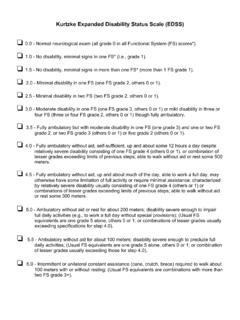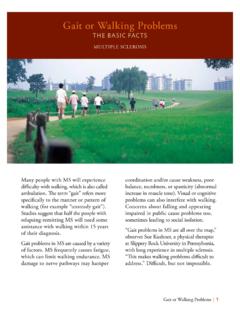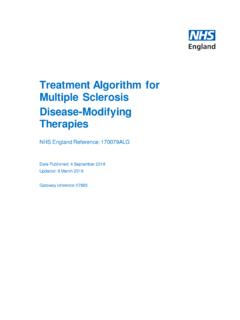Transcription of List of Medical Specialties - College of Human Medicine
1 List of Medical Specialties Allergy/Immunology An allergist-immunologist is trained in evaluation, physical and laboratory diagnosis, and management of disorders involving the immune system. Selected examples of such conditions include asthma, anaphylaxis, rhinitis, eczema, and adverse reactions to drugs, foods, and insect stings as well as immune deficiency diseases (both acquired and congenital), defects in host defense, and problems related to autoimmune disease, organ transplantation or malignancies of the immune system. As our understanding of the immune system develops, the scope of this specialty will widen. Match For positions starting in 2010, many programs will participate with the Electronic Residency Application Service.
2 Residency programs are not affiliated with a matching program. Residency Training Requirements Training programs are available at some Medical centers to provide individuals with expertise in both allergy/immunology and adult rheumatology, or in both allergy/immunology and pediatric pulmonology. Such individuals are candidates for dual certification. Training required: Prior certification in Internal Medicine or Pediatrics; two years in allergy/immunology. Subspecialties Pediatric Pulmonology Also, check out the American Academy of Allergy, Asthma & Immunology Anesthesiology Anesthesiology is the practice of Medicine which involves the perioperative care of patients and the treatment of pain. The field is predominately a hospital-based specialty, which cares for patients acutely pre-operatively, post-operatively and in critical care units.
3 It also involves the treatment of acute and chronic pain as one of its major subspecialties. The practice of anesthesiology includes a wide spectrum of patients: all ages, all degrees of illnesses and both sexes. The subspecialties include: pediatric, cardiac, neuro, obstetrical, ambulatory anesthesia as well as critical care Medicine and pain management. Individuals interested in anesthesiology are those who enjoy physiology and applied pharmacology in the clinical setting. They must be comfortable with managing acute life threatening problems and enjoy working in the operating room. Match Most programs participate in Electronic Residency Application Service and National Residency Matching Program. Residency Training Requirements 4 years, including a Clinical Base (or PGY-1) Year.
4 Moderately Competitive Subspecialties Pediatric Anesthesia, Cardiac Anesthesia, Obstetrical Anesthesia, Neuro Anesthesia, Critical Care Medicine and Pain Management A Clinical Base Year rotation is required, which includes training in internal Medicine or emergency Medicine , pediatrics, surgery or any of the surgical Specialties , critical care Medicine , obstetrics and gynecology, neurology, family practice, or any combination of these. Also, check out the American Society of Anesthesiology Dermatology A dermatologist is trained trs of the skin such as hair loss and scars, and the skin changes associated with diagnose and treat pediatric and adult patients with benign and malignant disorders of the skin, mouth, external genitalia, hair and nails, as well as a number of sexually transmitted diseases.
5 The dermatologist has had additional training and experience in the diagnosis and treatment of skin cancers, melanomas, moles, and other tumors of the skin, the management of contact dermatitis, and other allergic and nonallergic skin disorders, and in the recognition of the skin manifestations of systemic (including internal malignancy) and infectious diseases. Dermatologists have special training in dermatopathology and in the surgical techniques used in dermatology. They also have expertise in the management of cosmetic disorde Dermatologists see patients of all ages and backgrounds for various skin conditions. A typical practice setting is in either academia or private practice. Normal business hours are from 8:00-5:00 Monday through Friday for many practitioners, with some open on Saturday or with evening hours.
6 Most commonly, Dermatologists conduct biopsies and excisions, prescribe medications, and do surgery to remove benign/malignant cancers. It isn t all acne! Match Most programs participate in the Electronic Residency Application Service. Both PGY-1 and PGY-2 matching programs are operated through the National Resident Matching Program. Residency Training Requirements 4 years, including a broad-based PGY-1 year of training. Very Competitive Subspecialties Cutaneous Surgery, Pediatric Dermatology, Dermatopathology Also, check out the American Academy of Dermatology Emergency Medicine Emergency Medicine physiciannnual emergency department patient volumes may be over 90,000 patients. Emergency department volumes have increased in recent years.
7 Emergency physicians focus on the rapid diagnosis and initial resuscitation and treatment of patient problems and diseases. Emergency physicians enjoy problem-solving diagnostics. The practice also includes a variety of procedures including laceration repairs, some fracture ad dislocation reductions, management of major trauma, airway management including intubation and other procedures such as chest tubes, thoracentesis, paracentesis and arthrocentesis. s see all types of patients from pediatric to geriatrics, from Medical to surgical. Although people often equate emergency Medicine with trauma, major trauma cases comprise of less than 10% of emergency department patients. Over half of emergency department patients present with Medical illnesses.
8 Emergency Medicine is a hospital-based specialty in that one will see patients in a hospital emergency department and typically not a free-standing unit. Most emergency departments are in community hospitals with annual patient volumes of 15,000-35,000 visits per year. Typically, a group of physicians will contract with a hospital to provide coverage in the emergency department. In teaching hospitals and large academic centers, a Match Most programs participate in Electronic Residency Application Service and National Residency Matching Program Residency Training Requirements 3 years; no prerequisites Moderately Competitive Subspecialties Types of fellowships or subspecialties: Research, Pediatric, EM, EMS, Toxicology, Sports Medicine Organization or Interest Group Contact Emergency Medicine Interest Group Website: Also, check out the American College of Emergency Physicians Family Medicine A Family physician is trained to provide care to patients and their families with a focus on their community.
9 The care provided is continuing, comprehensive, coordinative, preventive, and delivered in a personalized manner to patients regardless of age, gender, presence of disease or organ system affected. Family physicians engage in a broad range of clinical activities that occur in the office, hospital, home, nursing home, extended care facility and other settings. Commonly performed procedures include vacesctomy, flexible sigmoidoscopy, colposcopy, skin biopsy, and casting and splinting. Family physicians practice in geographic setting ranging from rural, urban and everything in between. Match Most programs participate in Electronic Residency Application Service and National Residency Matching Program Residency Training Requirements 3 years Subspecialties Types of fellowships or subspecialties: Faculty Development, Sports Medicine , Geriatrics, Obstetrics, Research, Rural Medicine , Substance Abuse, Adolescent Medicine Also, check out the American Academy Family Physicians Surgery-General General Surgery encompasses a wide variety of disease process and patient populations.
10 Overall, it includes disease process such as cancers of the breast, endocrine glands, skin and gastrointestinal tract, the care of trauma and burn victims, and benign gastrointestinal problems which can range from peptic ulcer disease to biliary tract disease to inflammatory bowel disease. General surgeons also take care of more common problems such as hernias. There are several subspecialties that require training in general surgery prior to entering fellowship training. These include: Cardiothoracic Surgery, Pediatric Surgery, Vascular Surgery, and Colorectal Surgery. There is no typical practice setting. Practice settings can range from a pure private practice environment, where the surgeon is practicing alone, specifically without the presence of residents or students, to a University environment, where surgeons participate in the training of residents and Medical students, as well as teaching and doing basic or clinical research.






